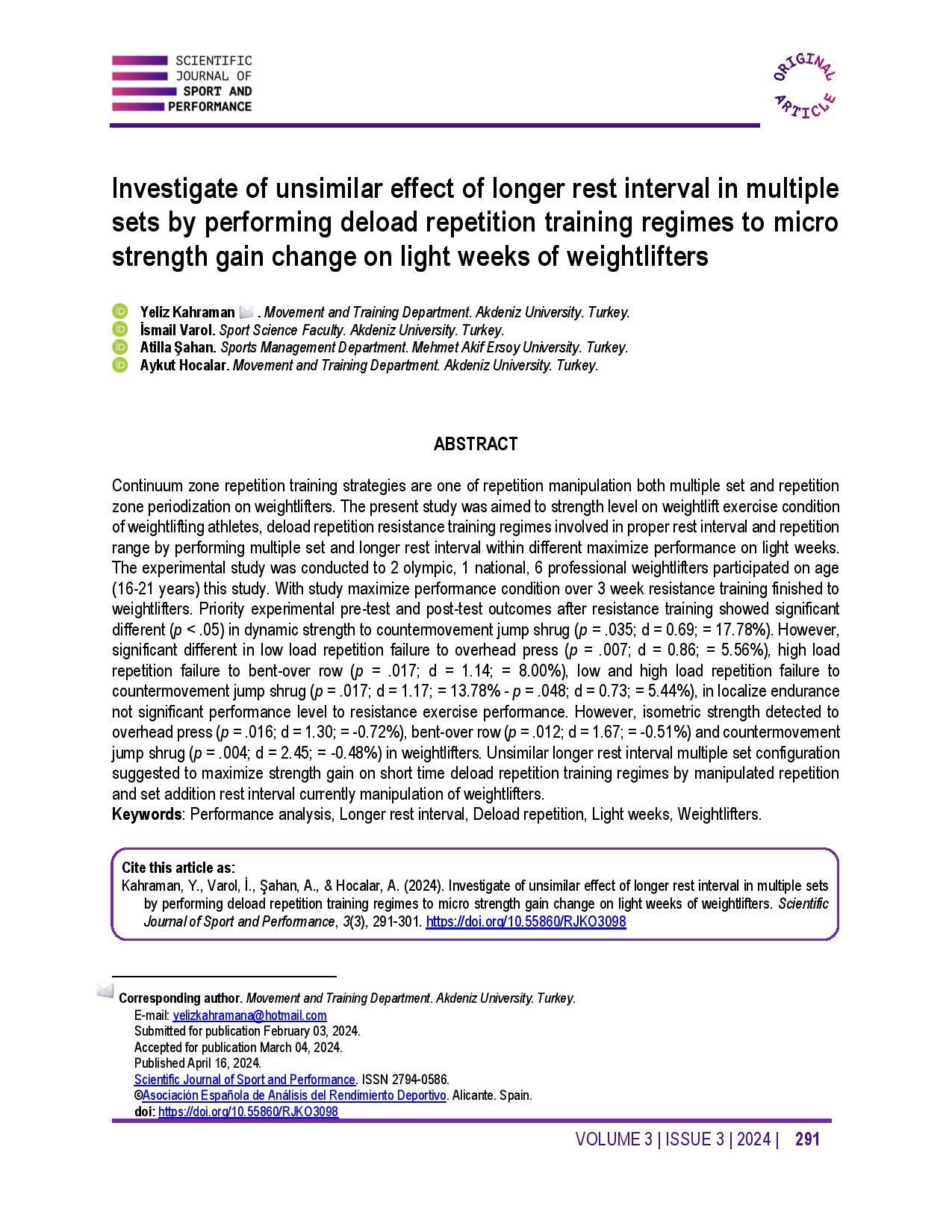Investigate of unsimilar effect of longer rest interval in multiple sets by performing deload repetition training regimes to micro strength gain change on light weeks of weightlifters
Main Article Content
Abstract
Continuum zone repetition training strategies are one of repetition manipulation both multiple set and repetition zone periodization on weightlifters. The present study was aimed to strength level on weightlift exercise condition of weightlifting athletes, deload repetition resistance training regimes involved in proper rest interval and repetition range by performing multiple set and longer rest interval within different maximize performance on light weeks. The experimental study was conducted to 2 olympic, 1 national, 6 professional weightlifters participated on age (16-21 years) this study. With study maximize performance condition over 3 week resistance training finished to weightlifters. Priority experimental pre-test and post-test outcomes after resistance training showed significant different (p < .05) in dynamic strength to countermovement jump shrug (p = .035; d = 0.69; = 17.78%). However, significant different in low load repetition failure to overhead press (p = .007; d = 0.86; = 5.56%), high load repetition failure to bent-over row (p = .017; d = 1.14; = 8.00%), low and high load repetition failure to countermovement jump shrug (p = .017; d = 1.17; = 13.78% - p = .048; d = 0.73; = 5.44%), in localize endurance not significant performance level to resistance exercise performance. However, isometric strength detected to overhead press (p = .016; d = 1.30; = -0.72%), bent-over row (p = .012; d = 1.67; = -0.51%) and countermovement jump shrug (p = .004; d = 2.45; = -0.48%) in weightlifters. Unsimilar longer rest interval multiple set configuration suggested to maximize strength gain on short time deload repetition training regimes by manipulated repetition and set addition rest interval currently manipulation of weightlifters.
Article Details

This work is licensed under a Creative Commons Attribution-NonCommercial-ShareAlike 4.0 International License.
References
American College of Sports Medicine (2009). American College of Sports Medicine position stand. Progression models in resistance training for healthy adults. Medicine and science in sports and exercise, 41(3), 687-708. https://doi.org/10.1249/MSS.0b013e3181915670 DOI: https://doi.org/10.1249/MSS.0b013e3181915670
Burcu, A., Tahir, K., & Yeliz , K. (2023). Multi joint short term resistance training strength zone evaluated on maximal strength, maximal ısometric strength, peak isom reach, maximal isometric endurance and muscular local endurance in resistance trained men. Revista De Gestão E Secretariado, 14(10), 18789-18801. https://doi.org/10.7769/gesec.v14i10.3081 DOI: https://doi.org/10.7769/gesec.v14i10.3081
Campos, G. E., Luecke, T. J., Wendeln, H. K., Toma, K., Hagerman, F. C., Murray, T. F., Ragg, K. E., Ratamess, N. A., Kraemer, W. J., & Staron, R. S. (2002). Muscular adaptations in response to three different resistance-training regimens: specificity of repetition maximum training zones. European journal of applied physiology, 88(1-2), 50-60. https://doi.org/10.1007/s00421-002-0681-6 DOI: https://doi.org/10.1007/s00421-002-0681-6
De Camargo, J. B. B., Brigatto, F. A., Zaroni, R. S., Trindade, T. B., Germano, M. D., Junior, A. C. T., DE Oliveira, T. P., Marchetti, P. H., Prestes, J., & Lopes, C. R. (2022). Manipulating Resistance Training Variables to Induce Muscle Strength and Hypertrophy: A Brief Narrative Review. International journal of exercise science, 15(4), 910-933.
de Salles, B. F., Simão, R., Miranda, F., Novaes, J.daS., Lemos, A., & Willardson, J. M. (2009). Rest interval between sets in strength training. Sports medicine (Auckland, N.Z.), 39(9), 765-777. https://doi.org/10.2165/11315230-000000000-00000 DOI: https://doi.org/10.2165/11315230-000000000-00000
Grgic, J., Schoenfeld, B. J., Skrepnik, M., Davies, T. B., & Mikulic, P. (2018). Effects of Rest Interval Duration in Resistance Training on Measures of Muscular Strength: A Systematic Review. Sports medicine (Auckland, N.Z.), 48(1), 137-151. https://doi.org/10.1007/s40279-017-0788-x DOI: https://doi.org/10.1007/s40279-017-0788-x
Hill-Haas, S., Bishop, D., Dawson, B., Goodman, C., & Edge, J. (2007). Effects of rest interval during high-repetition resistance training on strength, aerobic fitness, and repeated-sprint ability. Journal of sports sciences, 25(6), 619-628. https://doi.org/10.1080/02640410600874849 DOI: https://doi.org/10.1080/02640410600874849
Kraemer, W. J., & Ratamess, N. A. (2004). Fundamentals of resistance training: progression and exercise prescription. Medicine and science in sports and exercise, 36(4), 674-688. https://doi.org/10.1249/01.MSS.0000121945.36635.61 DOI: https://doi.org/10.1249/01.MSS.0000121945.36635.61
Krzysztofik, M., Wilk, M., Wojdała, G., & Gołaś, A. (2019). Maximizing Muscle Hypertrophy: A Systematic Review of Advanced Resistance Training Techniques and Methods. International journal of environmental research and public health, 16(24), 4897. https://doi.org/10.3390/ijerph16244897 DOI: https://doi.org/10.3390/ijerph16244897
Mangine, G. T., Hoffman, J. R., Gonzalez, A. M., Townsend, J. R., Wells, A. J., Jajtner, A. R., Beyer, K. S., Boone, C. H., Miramonti, A. A., Wang, R., LaMonica, M. B., Fukuda, D. H., Ratamess, N. A., & Stout, J. R. (2015). The effect of training volume and intensity on improvements in muscular strength and size in resistance-trained men. Physiological reports, 3(8), e12472. https://doi.org/10.14814/phy2.12472 DOI: https://doi.org/10.14814/phy2.12472
Shetty, A. B. (1990). Quantification of Selected Segmental Strengths In Weightlifting. Journal of Strength and Conditioning Research. 4(2): 37-41. https://doi.org/10.1519/00124278-199005000-00002 DOI: https://doi.org/10.1519/00124278-199005000-00002
Schoenfeld, B. J., Pope, Z. K., Benik, F. M., Hester, G. M., Sellers, J., Nooner, J. L., Schnaiter, J. A., Bond-Williams, K. E., Carter, A. S., Ross, C. L., Just, B. L., Henselmans, M., & Krieger, J. W. (2016). Longer Interset Rest Periods Enhance Muscle Strength and Hypertrophy in Resistance-Trained Men. Journal of strength and conditioning research, 30(7), 1805-1812. https://doi.org/10.1519/JSC.0000000000001272 DOI: https://doi.org/10.1519/JSC.0000000000001272
Schoenfeld, B. J., Grgic, J., Van Every, D. W., & Plotkin, D. L. (2021). Loading Recommendations for Muscle Strength, Hypertrophy, and Local Endurance: A Re-Examination of the Repetition Continuum. Sports (Basel, Switzerland), 9(2), 32. https://doi.org/10.3390/sports9020032 DOI: https://doi.org/10.3390/sports9020032
Soriano, M. A., García-Ramos, A., Torres-González, A., Castillo-Palencia, J., Marín, P. J., de Baranda, P. S., & Comfort, P. (2020). Comparison of 1-Repetition-Maximum Performance Across 3 Weightlifting Overhead Pressing Exercises and Sport Groups. International journal of sports physiology and performance, 15(6), 862-867. https://doi.org/10.1123/ijspp.2019-0582 DOI: https://doi.org/10.1123/ijspp.2019-0582
Willardson, J. M., & Burkett, L. N. (2006). The effect of rest interval length on the sustainability of squat and bench press repetitions. Journal of strength and conditioning research, 20(2), 400-403. https://doi.org/10.1519/R-16314.1. https://doi.org/10.1519/R-16314.1 DOI: https://doi.org/10.1519/00124278-200605000-00028




